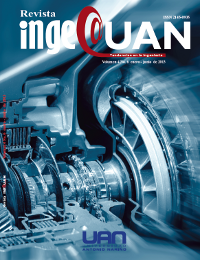Impacto de la minería subterránea en acuíferos: perspectivas en el contexto colombiano
Palavras-chave:
Aproximaciones conceptuales hidrogeológicas, minería subterránea, modelos númericos, efectos ambientalesResumo
En esta investigación se estudia el impacto de la minería subterránea en el recurso hídrico y algunas de las implicaciones conceptuales en el contexto colombiano. En particular, se estudian las implicaciones del uso de diferentes aproximaciones conceptuales en la modelación numérica de estos impactos. Se propone un protocolo de modelación útil para la simulación del impacto de la extracción continua de agua desde los túneles y los cambios (geo)químicos inducidos en la superficie y la subsuperficie. Este protocolo está enfocado principalmente en el análisis conceptuales hidrogeológicos relacionados con cambios en las direcciones de flujo y el comportamiento regional de los niveles freáticos comúnmente forzados por las prácticas mineras. Un protocolo de este tipo representa el punto de partida para la construcción de sistemas de soporte de decisiones que nos permitan el diseño de sistemas de monitoreo y seguimiento, así como el diseño de alternativas de mitigación y remediación. Para completar el estudio de las implicaciones del uso de diferentes aproximaciones teóricas para representar conceptualmente el acuífero asociado a una explotación minera se usa un medio fracturado creado sintéticamente. Los resultados muestran la gran relevancia que tiene el uso de una aproximación conceptual que incluya una caracterización geométrica detallada de las fracturas de tal manera que el modelo sea capaz de representar la respuesta real del acuífero. Los resultados también muestran las grandes diferencias entre el uso de una aproximación de fracturas discretas y el uso de un modelo de medio poroso equivalente, lo cual puede llegar a afectar el diseño de medidas de mitigación y control.
Downloads
Referências
Stokes, J., and R. Thunvik. "Investigations of Ground-Water Flow in Rock Around Repositories for Nuclear Waste." KBS Teknisk Rapport 47 (1978).
Blodgett, Steve. "Subsidence Impacts at the Molycorp Molybdenum Mine Questa, New Mexico." (2002).
Rapantova, N., Grmela, A., Vojtek, D., Halir, J., & Michalek, B. Ground water flow modelling applications in mining hydrogeology. Mine Water and the Environment, 26(4), 264-270, 2007
Cidu R, Frau F. “Influence of fine particles on the concentration of trace elements in river waters”. In: Bullen TD, Wang Y (eds) Proc, WRI-12, July 31-Aug 5, 2007. Kunming/Taylor & Francis, PR China/London, pp 1471–1474
Cook, P.G. A guide to regional groundwater flow in fractured rock aquifers. Adelaide (AU). Pp. 100, 2003.
Snow, D. T. Rock fracture spacings, openings, and porosities. Journal of Soil Mechanics & Foundations Div, 1968
Snow, David T. "The frequency and apertures of fractures in rock." International journal of Rock mechanics and Mining sciences & Geomechanics Abstracts. Vol. 7. No. 1. Pergamon, 1970.
De Marsily, Ghislain, Ghislain De Marsily, and Ghislain de Marsily. Quantitative hydrogeology: groundwater hydrology for engineers. Vol. 440. San Diego, California: Academic Press, 1986.
McKay, L. D., J. A. Cherry, and R. W. Gillham, Field experiments in a fractured clay till, 1, Hydraulic conductivity and fracture aperture,Water Resour. Res., 29(4), 1149 –1162, 1993a.
Therrien, R., R. McLaren, E. A. Sudicky, and S. Panday, HydroGeoSphere, A Three-Dimensional Numerical Model Describing Fully-Integrated Subsurface and Surface Flow and Solute Transport, Groundwater Simul. Group, Waterloo, Ont., Canada, 2006.
Cochran, William G. "The χ2 test of goodness of fit." The Annals of Mathematical Statistics (1952): 315-345.
A.J. Pérez, R. Abrahão, J. Causapé, O.A. Cirpka, C.M. Bürger, Simulating the transition of a semi-arid rainfed catchment towards irrigation agriculture, Journal of Hydrology, Volume 409, Issues 3–4, 9 November 2011, Pages 663-681
Refsgaard, Jens Christian. "Parameterisation, calibration and validation of distributed hydrological models." Journal of Hydrology 198.1-4 (1997): 69-97.
Ebel, Brian A., and Keith Loague. "Physics‐based hydrologic‐response simulation: Seeing through the fog of equifinality." Hydrological Processes20.13 (2006): 2887-2900.
Kirchner, James W. "Getting the right answers for the right reasons: Linking measurements, analyses, and models to advance the science of hydrology."Water Resources Research 42.3 (2006).
Klemeš, Vit. "Operational testing of hydrological simulation models."Hydrological Sciences Journal 31.1 (1986): 13-24.
Klemeš, V. "Hydrological and engineering relevance of flood frequency analysis." Hydrologic Frequency Modeling. Springer Netherlands, 1987. 1-18.
Loague, Keith, and Joel E. VanderKwaak. "Physics‐based hydrologic response simulation: Platinum bridge, 1958 Edsel, or useful tool." Hydrological Processes 18.15 (2004): 2949-2956.
Bear, Jacob. Dynamics of fluids in porous media. Courier Dover Publications, 1972.
Downloads
Publicado
-
Resumo493
-
PDF (Español)196
Como Citar
Edição
Seção
Licença

Este trabalho está licenciado sob uma licença Creative Commons Attribution-NonCommercial-ShareAlike 4.0 International License.



 Portal de Ciencia Abierta
Portal de Ciencia Abierta